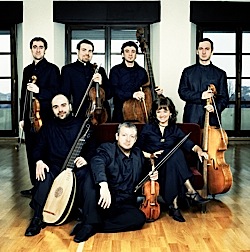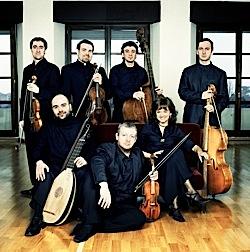
As a soloist, Biondi is well-known for pushing the interpretive envelope through performances of irrepressible verve, passion, and drive — or, as one critic bluntly called it, “going hell for leather.” Unsurprisingly, this approach carries over to Europa Galante, as well, which is rooted in a desire to liberate historical performance from conventional dogmas. “My aim is that Europa Galante will bring its own twenty-first-century reading, a contemporary perspective to Baroque music,” Biondi noted in an interview published in Goldberg magazine several years ago. “It’s not a question of re-creating music as we think it was played in the past, but of allowing it to be heard afresh through a modern prism.”
In crafting these new approaches, Biondi does a good deal of homework, fervently researching early Italian repertory and the conditions that allowed it to thrive. “By removing the cobwebs from works that are no longer well-known, we can gradually understand these [conditions],” he states. “There is so much to discover. Libraries are full of treasures just waiting to be found; their collections are amazingly rich, even in terms of major composers.” Especially attracting his interest are composers who were popular in their own lifetime but are ignored nowadays. “Locatelli, for instance, was unknown until [recently], but in the eighteenth century his bold, virtuosic instrumental writing made him one of the stars of the musical firmament,” Biondi notes.
This “Locatelli” refers to Pietro Antonio Locatelli, whose virtuosity shines brightly in his Concerto Grosso Op. 1, No. 5. This piece exploits the technical fluidity that has led some to call Locatelli a predecessor to Paganini. It’s also one of the more enlivening works on Europa Galante’s program, along with Giovanni Battista Sammartini’s Sinfonia in G Minor, JC 57, a work of throbbing buoyancy that anticipates the Sturm und Drang style of Franz Joseph Haydn.
For more sweetly sounding ear candy, Pietro Nardini’s Concerto for Violin Op. 1, No. 1, fits the bill. As both a composer and a violinist, Nardini embraced qualities of melodic grace and sentimentality, prompting Leopold Mozart to observe that “the beauty, purity and equality of his tone, and the tastefulness of his cantabile playing, cannot be surpassed; but he does not execute great difficulties.” Also on the lighter side is Georg Philipp Telemann’s Ouverture à Quatre, in F major, heavily influenced by French rococo style, while Arcangelo Corelli’s Concerto Grosso Op. 6, No. 11, bridges the gap between sweet and scintillating.
A final work on the program is Telemann’s Concerto in A Major for flute, violin, cello, and strings, TWV 53. Although renowned for his eye-popping productivity in all musical genres (he was dubbed “most prolific composer” by the Guinness Book of World Records not long ago), Telemann professed ambivalence toward the concerto, claiming that “since the concerto form was never close to my heart, it was immaterial to me whether I wrote a great many or not.” He nevertheless ended up being a typical overachiever, writing more than 170 such works.

